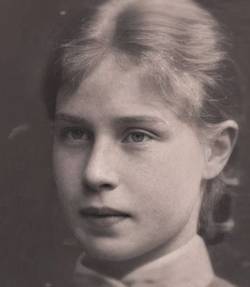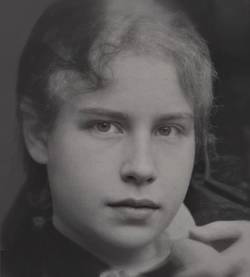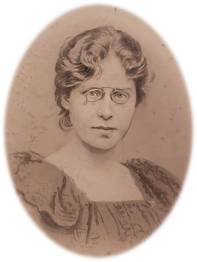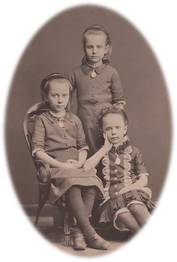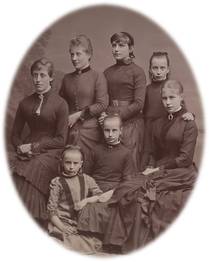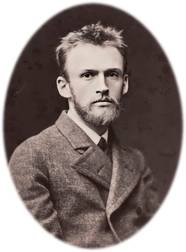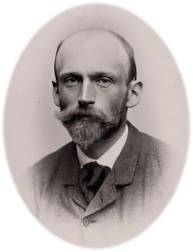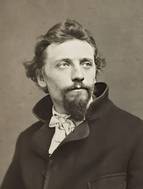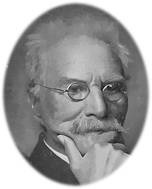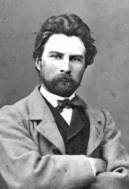1888.05.21 English
Copenhagen, May 21, 1888[1]
My dearly beloved Emma. Mother and all of us thank you so very much for your last letter. It is quite extraordinary how your handwriting is so very similar to that of uncle Jørgen; one would imagine that kinship plays a role in this. Here we have been thrown from winter right into summer, without any kind of intervening spring. On May 15 we had only 5 R[2] and in addition a strong wind; even in my winter coat I was freezing. 3 days later we had tropical heat and 19 R[3] that in one single day brought out the green color in trees and shrubs. The heat abated somewhat yesterday, but I am still sitting in front of an open window writing this to my dear Emse. Add to the picture that I have a long pipe in my mouth; I have reverted to the pipe habit of my youth and feel happy with that. It was my good friend Feilberg, who by presenting me with a well seasoned pipe (lovely)for my last birthday managed to convert me from the cigar to the pipe. And then the great and almost international exhibition was opened. Since I am not exhibiting - and being too insignificant to be graced with an invitation - I didn’t participate in the opening ceremony. I would have enjoyed very much hearing the magnificent cantata. --- and yet – I take up considerable exhibition space in the exhibit area of Mr Lyngbye, the mechanic, with no less than seven copies of the writing ball (with my permission), showing its various stages of development. It is very well done, looks excellent.
In addition, Mr Berg, the scale maker, shows a copy of the kind of scales (centner???) on which I weigh some 20 children simultaneously[4]. Both places ???? my name.
And yes – I myself am exhibited in Engelstedt’s excellent painting of the L’Hombre four game, actually it is somewhat exaggerated to call it an ongoing game; we played only once during last year, and I don’t think we have ever managed more than four times a year.
The picture and the writing balls (…..?) make an exceedingly good appearance, according to Engelke and Zarah[5], they went to the exhibition on Whit Monday together with Cecilie; for a full 5 hours they trudged around, working with their eyes, were satiated and returned home dog-tired and with empty stomachs. Cecilie is, as I write, in full swing at one of the tombolas;the raffle tickets are selling like hot cakes; with her is a miss Treibov (?) an 18 year old daughter of my friend, since long time departed, a head teacher Tr. from Schleswig Town. It is quite a nice coincidence that has given me a lot of pleasure. Mrs Treikov – who I havn’t seen for some 20 years – is presently ill and bedridden. The tombola work can otherwise be quite tedious. The two young lasses are exposed to being cheekily accosted, but it appears that Cecilie is mature enough to cope with such things with the necessary tranquility and coldness. At both tombola stalls yesterday the top prize was won, I believe it was a cash prize of 1000 kroner. Today mother[6] and I will pay a visit and then once again during the week with the three small ones. Who incidentally are growing big. Karen is taller than Juliane and Johanne is as tall as Juliane[7].
Karen has developed into a very hard-working pupil at her school; if she continues this way, I guess she will surpass both her sisters[8]. However, with the success and the happiness around it, also a bit of jealousy has been aroused: It is as if Goodness cannot thrive without Evil also trying to gain momentum, the same way as good seed and weed is thriving best in well-prepared fertile soil, - and hence one must, of course, weed and clean.I have been appointed member of the board for Sunday schools for apprentices and hope to be able to be of some use there. In connection with that, and also because of the usual yearly celebration in the Cathedral of Copenhagen, I dined at Court with their Majesties the other evening, I was placed between the two painters Bloch[9] and Otto Bache[10] and had an interesting conversation with both of them. These days we are carrying out the usual whitewashing of the institute. This summer we will have 7 weeks of holiday because of the comprehensive refurbishment of the institute. 11.000 kroner has been allocated for this purpose. You will see great changes upon your return. Yes, dear beloved child, I am still hoping that Vicar Nielsen will be appointed to a post in Denmark, we are longing so much for our dear Emse.Very soon you will have been away from us for a full year. You have probably grown physically and mentally. It is evident to me that dear mother and I have been graying quite considerably during the last year, but thank God we have enjoyed good health (?).There are fond greetings from your loving mother and your dear sisters and foster daughter Cecilie. Engelke[11] is doing exceeding well in her position. However, it was a great disappointment and sorrow that Juliane[12], after two years of hard work with Miss Tiedemann, didn’t reach the point where she could do the final examination. What to do now?Mother is busy in the garden with old Jens Pedersen. Other folks have joined in (?). I am still very happy with my work concerning weighing and measuring, and I am at present involved in a major effort of having weighing stations established all over the world.
Fondest greetings and kisses for my dear Emse
Your deeply devoted father
R. Malling-Hansen
[1] CB: This letter from RMH we don’t have in the original – only as a copy obtained from Elsebeth Erlangsen in Korsør, a daughter of Emma – RMH’s daughter number 3, to whom this letter was addressed. Emma was born in 1869, and was therefore 18 or 19 years old at the time. Mrs Erlangsen died around 1995.
Where might the original be ?? With the descendants? The original letter was handwritten. In other words, RMH didn’t even have his own writing ball at disposal! In several places the old lady, Elsebeth Erlangsen – who used a magnifying glass for reading - hasn’t been able to decipher the writing. Hence the ???? and quite possibly there are several errors in the copy.
[2] JMC: RMH is using the Réaumur temperature scale, according to which water boils at 80 degrees. 5 degrees Réaumur is equal to 6,25 degrees Celsius.
[3] JMC: 23,75 C
[4] CB: This is an interesting piece of information: That the scales RMH used for weighing the pupils at the Institute for the Deaf-Mute were exhibited at an industrial exhibition. I have always been under the impression that he used the already existing type of cattle scale. However, they were probably not sufficiently precise for RMH’s weighing that needed to register even tiny weight changes. If the supposition is correct – that RMH paid also to develop such specialized scales – then it is certainly no wonder that he had financial problems!
[5] CB: Engelke and Zarah are two of RMH’s daughters. Cecilie is a foster daughter, as the letter explains later on.
[6] CB: “Mother” is the second wife of RMH, stepmother of the 7 daughters, Anna Steenstrup. It is odd that he writes “the three small ones”. The three youngest daughters are Johanne, Karen and Marie, born in 1873, 1874 and 1875 – hence 13, 14 and 15 years old!
[7] CB: Juliane is the eldest daughter – born 1866 – and hence 22 years old in 1888.
[8] CB: But – she has four elder sisters, doesn’t she?
[9] JMC: Carl Heinrich Bloch (1834-1890) was an important painter in the second half of the 19th century, considered by his contemporaries to be one of the most gifted Danish painters. He is seen as the last great painter in the category of painters who focused on historical works in the style of the late romantic school.
[10] JMC: Otto Bache (1839-1927) was admitted by the Royal Danish Academy of Fine Arts already by the age of 10! After academy studies he travelled and studied in the Netherlands, Belgium and France. Returning to Denmark he pursued three kinds of painting themes throughout his life: animals, history and portraits. As one of the first painters ever, he would paint scenes from the ordinary Copenhagen street life. In essence, he continued the tradition of painters like Eckersberg and Marstrand who embodied the Danish so called Golden Age of painting.
[11] CB: The second eldest daughter
[12] CB: Eldest daughter
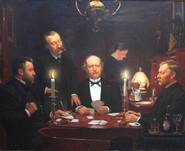
- Rasmus Malling-Hansen and his good friends, Erik Ritzau, Gustav Feilberg and Johannes Kaper could be seen in this painting which was exhibited at the great Art and Industry Exhibition in 1888.


